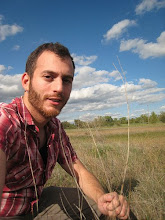Sorry about the cold shoulder... I've been--distracted. By things. Plus, there weren't too many wildernesses left to explore in Long Beach!
All that changed this past weekend, though. We have a brand new wetland!
The Dominguez Gap Wetlands were officially opened to the public this May.
These wetlands are located along the LA River south of Del Amo Boulevard, adjoining DeForest Park. But unlike DeForest, this isn't techinically a "park" and it isn't managed by the Long Beach Parks Department. Instead, it's managed by the LA County Department of Public Works.
Adjacent to the park, you can see the confluence of Compton Creek and the LA River:
These wetlands aren't at all natural--they were constructed and serve a variety of purposes. Specifically, the wetlands are designed to treat stormwater (removing nutrients and metals before it enters the LA River and the Pacific Ocean. It will also help recharge the groundwater in the area. In addition, the wetland provides habitat for wildlife. And wetland-dependent wildlife is desparate for real estate in southern LA County! (You can learn more about constructed treatment wetlands in this PDF from the EPA).
As you can see, the wetlands are built so that water enters individual cells. In each cell, nutrients and pollutants are removed, before passing on to the next cell. As the water moves through the wetland, more and more pollutants are removed.
Tules and other wetland plants separate the cells.
The slopes of Dominguez Gap are flowering with a riot of colors right now.
The yellow spikes of flowers are false-lupines (Thermopsis macrophylla). In addition, poppies, sages, chia, and limnanthus were flowering profusely.
This hummingbird sage (Salvia spathacea) is more typical of oak-woodland habitat.
The landscapers were clearly going for more of a "grassland" than coastal sage-scrub, which may have been more appropriate. But I'm sure they had their reasons. No doubt the appearance of the wetlands will change drastically as the plants duke it out with each other (and the inevitable invasion of mustards and other weeds). Sapling cottonwoods and sycamores may eventually tower over the whole park.
The plants may have been utterly delicious to these caterpillars:
Not sure which species they were, but there were hundreds of them on the trails!
Perhaps some would turn into mourning cloaks, like this one I saw:
Needless to say, the birds weren't letting the abundance go to waste, as this mockingbird shows us:
The birdlife was fantastic. I saw huge flocks of blackbirds, including red-winged, tricolored, and yellow-headed blackbirds.
Red-winged blackbirds (Agelaius phoeniceus) are common birds in marshes, and will probably do well at Dominguez Gap. Their songs are beautiful and evocative.
Tricolored blackbirds (Agelaius tricolor) are much rarer (in fact, they are species of special concern in California). They have similar wings (with white replacing the yellow on the epaulets), but the black is also much glossier.
Yellow-headed blackbirds (Xanthocephalus xanthocephalus) were new to me! They traveled in the largest flocks (which included the other species of blackbirds, as well as a few starlings). Very cool-looking creatures!
Some other neat birds at this park:
American goldfinch (Carduelis tristis)
Lesser goldfinch (Carduelis psaltria). It's distinguished from the American goldfinch by its larger black cap.
Double-crested cormorant (Phalacrocorax auritus)
A mother mallard and ducklings!
Oh, and cowboys!

3 comments:
Anybody home? My friends and I would like to contribute pictures, observed species lists,and trip reports of our frequent visits to "the Gap". We represent years of experience in field ornithology, herpetology, entomology, arachnology, mammology and native calif. botony. How can we best contribute to this wonderful urban riparian habitat?
My husband just discovered the park and took me there on Friday, May 22. We saw multiple Coots with their glow-in-the-dark-orange headed babies! It was awesome. Also saw several black-crowned night herons and one green heron. It is a really amazing spot and we plan to spend a lot more time there.
This is a beatiful and hidden park area running along side the stench of the LA River. This development provides a filter system for cleaner water while allowing a man-made creek system to flourish in the open environment. I guess the real concern is if this new development would, over time, turn into it's paralleling counterpart.
Post a Comment